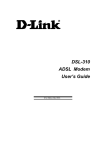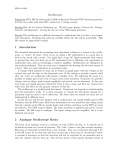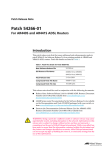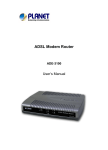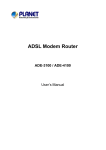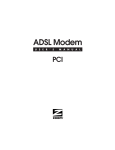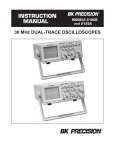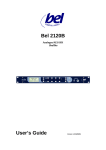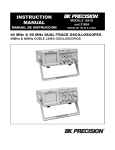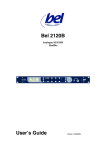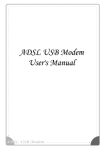Download Planet Technology ADU-2120 User's Manual
Transcript
USB ADSL Modem ADU-2120 User’s Manual Copyright Copyright (C) 2004 PLANET Technology Corp. All rights reserved. The products and programs described in this User’s Manual are licensed products of PLANET Technology, This User’s Manual contains proprietary information protected by copyright, and this User’s Manual and all accompanying hardware, software, and documentation are copyrighted. No part of this User’s Manual may be copied, photocopied, reproduced, translated, or reduced to any electronic medium or machine-readable form by any means by electronic or mechanical. Including photocopying, recording, or information storage and retrieval systems, for any purpose other than the purchaser's personal use, and without the prior express written permission of PLANET Technology. Disclaimer PLANET Technology does not warrant that the hardware will work properly in all environments and applications, and makes no warranty and representation, either implied or expressed, with respect to the quality, performance, merchantability, or fitness for a particular purpose. PLANET has made every effort to ensure that this User’s Manual is accurate; PLANET disclaims liability for any inaccuracies or omissions that may have occurred. Information in this User’s Manual is subject to change without notice and does not represent a commitment on the part of PLANET. PLANET assumes no responsibility for any inaccuracies that may be contained in this User ’s Manual. PLANET makes no commitment to update or keep current the information in this User ’s Manual, and reserves the right to make improvements to this User’s Manual and/or to the products described in this User’s Manual, at any time without notice. If you find information in this manual that is incorrect, misleading, or incomplete, we would appreciate your comments and suggestions. FCC Compliance Statement This equipment generates and uses radio frequency energy and if not installed and used properly, that is, in strict accordance with the instructions provided with the equipment, may cause interference to radio and TV communication. The equipment has been tested and found to comply with the limits for a Class A computing device in accordance with the specifications in Subpart B of Part 15 of FCC rules, which are designed to provide reasonable protection against such interference in a residential installation. However, there is no guarantee that interference will not occur in a particular installation. If you suspect this equipment is causing interference, turn your Ethernet Switch on and off while your radio or TV is showing interference, if the interference disappears when you turn your Ethernet Switch off and reappears when you turn it back on, there is interference being caused by the Ethernet Switch. You can try to correct the interference by one or more of the following measures: w Reorient the receiving radio or TV antenna where this may be done safely. w To the extent possible, relocate the radio, TV or other receiver away from the Switch. w Plug the Ethernet Switch into a different power outlet so that the Switch and the receiver are on different branch circuits. If necessary, you should consult the place of purchase or an experienced radio/television technician for additional suggestions. CE mark Warning The is a class B device, In a domestic environment, this product may cause radio interference, in which case the user may be required to take adequate measures. Trademarks The PLANET logo is a trademark of PLANET Technology. This documentation may refer to numerous hardware and software products by their trade names. In most, if not all cases, these designations are claimed as trademarks or registered trademarks by their respective companies. Revision User’s Manual for PLANET USB ADSL Modem Model: ADU-2120A / ADU-2120B Rev: 1.0 (JAN. 2004) Part No.: EM-ADU2120 TABLE OF CONTENTS CHAPTER 1 INTRODUCTION ................................................................................. 1 FEATURES .............................................................................................................. 1 DATA REQUIREMENT................................................................................................ 1 ADSLRFC1483 mode user............................................................................... 1 ADSL PPPoE/PPPoA mode user ..................................................................... 1 SYSTEM REQUIREMENT ........................................................................................... 2 LED DEFINITION...................................................................................................... 2 CHAPTER 2 INSTALLATION................................................................................... 3 HARDWARE INSTALLATION........................................................................................ 3 DRIVER INSTALLATION WITH W INDOWS 98 ................................................................ 3 DRIVER INSTALLATION WITH W INDOWS ME............................................................... 5 DRIVER INSTALLATION WITH W INDOWS 2000 ............................................................ 6 DRIVER INSTALLATION WITH W INDOWS XP ............................................................... 9 DRIVER CONFIGURATION ....................................................................................... 11 CHAPTER 3 PPPOE AND PPPOA CONFIGURATION......................................... 15 ADSL LAN CONFIGURATION ................................................................................. 16 CHAPTER 4. USER INTERFACE .......................................................................... 17 ACCESSING CSA .............................................................................................. 17 CSA USER SCREEN.......................................................................................... 17 CHAPTER 5. UNINSTALL MODEM....................................................................... 20 USB MODEM UNINSTALLATION ............................................................................... 20 CHAPTER 6. TROUBLESHOOTING ..................................................................... 21 CHAPTER 7. ABBREVIATIONS ............................................................................ 22 Chapter 1 Introduction 1 PLANET USB ADSL modem ADU-2120 is designed to provide cost-effective access to high-speed ADSL services. With our ADSL modem, surfing on Internet is just like driving a sport car on the Express Highway. Video on Demand, Videoconference and any high-speed Internet applications is not a dream any more. But a reality! Features l l l l l l l USB bus-powered; an external power supply is not required ANSI T1.413 issue 2, ITU G.dmt(G.992.1), and ITU G.lite(G.992.2) compliant Software upgradeable Support the following three modes n PPP over ATM LLC or VCMUX (RFC 2364) n PPP over Ethernet LLC or VCMUX (RFC 2516) n RFC 1483 LLCSNAP/VC-MUX Bridged IP over ATM, LLC or VCMUX (RFC 1483) Routed IP over ATM LLC or VCMUX (RFC 1483) Supports DSL downstream data rates up to 8 Mbps Supports DSL upstream data rates up to 1 Mbps Compliant with Universal Serial Bus Specification Revision 1.1 Data Requirement You must get the following data information from your ISP or phone company to set up ADU-2120. ADSLRFC1483 mode user l l l l VPI/VCI value Encapsulation mode(example: RFC 1483...etc.) IP Address, Subnet Mask Gateway, DNS related information ADSL PPPoE/PPPoA mode user l l l VPI/VCI value Encapsulation mode (example: RFC 2364, 2516...etc.) Username and password for authentication 1 System Requirement l l l l Mainboard with USB support Pentium II CPU and above or compatible RAM: 64M or above Windows 98SE, Windows 2000, Windows ME, Windows XP, Windows 2003 Server NOTE: For Windows XP it is recommended that your PC have at least 128 M Bytes of memory. LED definition Below is the front panel of ADU-2120 and its LEDs definition. LED USB – Red USB – Green ADSL – Red ADSL - Green Definition Flashing when is attaching and configuring Solid green when the connection to PC is OK and the driver is well installed. Flashing when the software downloading from PC is successful. Flashing when is trying to connect to ADSL DSLAM Solid green when is ready for dial-up connection 2 Chapter 2 Installation 2 Please refer to the following steps to complete ADU-2120 installation. Hardware Installation 1. Turn on your PC 2. Insert the rectangular end of a USB cable into the USB port of your PC. Then, insert the square end of the USB cable into the USB port of the ADU 2120. 3. PC will automatically detect this modem as “DynaMiTe USB Modem”. 4. Insert bundled USB driver CD into the proper drive and follow instruction to install ADU 2120. Driver Installation with Windows 98 1. The “Add New Hardware Wizard” will be displayed. Click Next. 2. Choose the “search for a better Driver (Recommended)” and click Next. 3 3. Choose “Specify a location”. Then click “Browse” to find out the driver location to install. (Assume "E" is your CD-ROM drive, the driver can be found in E:\driver\ADU-2120B) then click OK. Please then click “Next” to continue. 4 4. The Add New Hardware Wizard will appear and indicate the PLANET ADU-2120 USB ADSL modem has been recognized and will install a new driver. Click Next 5. Please then go to Section “Driver Configuration” for further configuration. Driver Installation with Windows ME 1. The “Found New Hardware Wizard” will be displayed. Insert ADU-2120 driver CD and click Next. 5 2. Please specify the path which ADSL modem connected your computer to Internet, then click OK. Please select the directory with ADU-2120 driver and then click “OK”. 3. Please then go to Section “Driver Configuration” for further configuration. Driver Installation with Windows 2000 1. The “Add New Hardware Wizard” will be displayed. Please click Next. 6 2. Choose the “Search for a suitable driver for my device (recommended)”, and click Next. 3. Next you will be prompted for software drivers. Select Specify a location. 7 4. Insert the ADSL Driver CD into your systems CD-ROM drive and then click “Browse” to find out the driver location to install. (Assume "E" is your CD-ROM drive, the driver can be found in E:\driver\ADU-2120B) then click OK. 5. The Found New Hardware Wizard will then find the ADSL USB MODEM, click Next. 8 6. The “Digital Signature Not Found” window will pop-up, Click Yes. 7. Please then go to Section “Driver Configuration” for further configuration. Driver Installation with Windows XP 1. The “Add New Hardware Wizard” will be displayed. Choose Install from a list or specific location (Advanced) and click Next. 9 2. Insert the ADSL Driver CD into your systems CD-ROM drive, select “Include this location in the search” and then click “Browse” to find out the driver location to install. (Assume "E" is your CD-ROM drive, the driver can be found in E:\driver\ADU-2120B). Click “Next” to continue. 10 3. The Hardware Installation window appears. Click Continue Anyway. 4. Now please go to Step 3 for driver configuration. Driver Configuration Step 3: Driver Configuration 1. The system will start to copy the driver and utility files to your PC. After completing, the ADSL Modem Driver Suite installation page is shown. Click “Next” to continue. 2. The modem driver version is shown. Click “Next” to continue. 11 3. On this page, you need to select the operation mode (RFC 1483, PPPoA or PPPoE) and input the VPI / VCI values per your ISP’s requirement. Click “Next” to continue. 12 4. Please then select the framing type your ISP uses: LLC or VCMUX/NULL. 5. If you select RFC 1483, you will then need to specified if it is Bridged or Routed RFC 1483. Your ISP should also provide this information. 13 6. The system will then ask you to reboot your PC. Please select “Yes, I want to restart my computer now” and click OK to finish this setup procedure. 7. After reboot, the system will ask you to install the driver again. “Install the software automatically“ and click “Next” to continue. Please select 14 3 8. The Hardware Installation page is shown. Windows XP and “OK” on Windows 2000 Please select “Continue Anyway” or 3. The Found New Hardware Wizard window appears and displays your newly installed PLANET ADU-2120 USB ADSL Interface, then click Finish. The system may ask you to reboot again. Please select “Yes” to reboot if asked. Chapter 3 PPPoE and PPPoA Configuration 15 ADSL LAN Configuration To configure the connection, after you have installed the appropriate driver: 4 Step 1. Click either the desktop icon, or the Dial-Up Networking icon to open the Connect To window. For Windows XP, please click “Start” -> “Settings” -> “Network Connections” and then click the ADSL or PPPoE on the “Dial-up” option. Step 2. Provide the following information Step a. Supply the User Name. Step b. Supply the Password. Step c. Click the field for Save Password, if you want the system to remember the password. Step d. Click DIAL to set up the connection. NOTE: The data for the Phone number field has been furnished by your service provider. Note: There is a known issue for PPPoA in case of Windows 98 Second Edition and Windows Millennium. Extra disabled adapters may appear in Device Manager. These extra adapters do not affect the functionality of the enabled adapter. However, do not remove the disabled adapters. Check this link for more information .http://support.microsoft.com/default.aspx?scid=kb;EN-US;q279116 16 Chapter 4. User Interface ACCESSING CSA The User Interface to the ADSL Modem is provided by the Control and Status Application (CSA). You can access the CSA by double-clicking on the CSA icon in the System Tray, located near the clock on the task bar. The icon, which appears as two monitor screens, also changes color to indicate the status of the modem (see Table 1. ICON Condition.). If the icon does not appear in the System Tray, it can be restored by any of the following methods: • Restart the PC. • Click the Windows START button, then Programs, ADSL Modem Driver, and Add CSA Tray Icon. • Go to the CONTROL PANEL and double-click the ADSL Control and Status icon. While connected, the System Tray CSA icon provides pop-up text that gives information about the current ADSL connection. This text appears when the cursor is placed over the icon. The information displayed is: • bytes transmitted • bytes received • connection rate. Table 1. ICON Condition Color Condition Black The modem is not available. Red The modem is disconnected. Blue The modem is waiting for initialization. Yellow The modem is initializing. Green The modem is connected and functioning. CSA USER SCREEN 17 Modem Performance The Modem Performance displays performance information. The primary purpose is to display the instantaneous throughput rate for both transmit and receive paths of the modem. This rate is calculated based on the poll period (generally 2 seconds) and the number of bytes passed during that time. Transmit and Receive The throughput is indicated through two bar graphs, each provides a maximum rate label indicating the transmit and receive bit rates currently in use. The bar graph displays peak throughput rates over the last 10-second period. Basically, the user interface records the instantaneous throughput for each poll period over the last 10 seconds, and the peak rate is displayed as the maximum value achieved over that 10-second period. This value is indicated on the throughput graph with a vertical red marker indicating the peak rate. The user interface displays operational information about the ADSL modem, relevant when the modem is connected. When the modem is not connected, all of the non-averaged operational information are reported as zero unless otherwise CSA User Screen Connection Status noted. This means that when the modem is disconnected, these values should immediately report zero. Connection Status The Connection Status field changes to indicate the status of the modem connec18 tion: • ADSL link connected • ADSL link disconnected Device Status The Device Status field changes to indicate the status of the modem connection: • ADSL Modem available • ADSL Modem not available Connect/ Disconnect Button The CONNECT/DISCONNECT button performs the connection/disconnection operation. If the ADSL Modem is unavailable, the button is disabled. This occurs when the ADSL modem driver is disabled or fails to communicate correctly. Close Button The CLOSE button closes the main interface screen. If the main window was displayed while the system tray icon was present, then the application continues to execute - hiding the main screen. If for some reason the icon is not present, however, the application is terminated. Help On-line help is available through the HELP screens. Press the F1 key at the CSA main screen to see the Help table of contents. This is available from the context menus and system tray icon menus Help selection. AboutCSA The ABOUTCSA button displays the product information, including the version number and date. 19 Chapter 5. Uninstall Modem 5 USB Modem uninstallation USB MODEM To uninstall the software and hardware for the USB ASDL Modem, perform the following: Step 1. Detach the USB Modem from your computer. Step 2. At Windows Start, click on Programs > ADSL Modem Driver > Remove ADSL Modem Driver. Step 3. A Question screen asks for verification of an uninstallation. Click YES to continue. Step 4. At the Rebooting Machine screen, click the radio button for Yes, I want to restart my computer now, and then click OK to complete the uninstallation. The system is restarted. You have successfully uninstalled the software and hardware for the modem. 20 Chapter 6. Troubleshooting 6 If your internet connection is not working, the following hints may be helpful. After trying these hints, if you still can not make your connection work, it is recommended that you ask your service provider for assistance. To run troubleshooting on the system: Step 1. Is the system tray CSA icon green? If it is not, try a restart of your PC. This may clear the problem. Step 2. If this does not correct the problem, make the following checks: Step a. Is your phone line connected to the wall outlet and to your modem? Step b. For USB. Is the modem connected to the USB port? Step 3. If the CSA icon color does not show green after performing the steps above, it is recommended to "cleanup" the installation and reinstall. "Cleanup" is a utility that can be run from the Installation CD. At the Windows Start button, select Run, click Browse and search for "Cleanup.exe" on the installation CD. Once you Run the utility, it pops up a message for restarting the system. Re-install the modem after a restart. Step 4. If the CSA tray icon is still not showing green uninstall the modem (see “Chapter 5. Uninstall Modem”) and re-install. Step 5. If the system tray CSA icon is green, but you have problems in logging in, or connecting to, your ISP, running "Cleanup’ and reinstalling may solve the problem (see "Step 3" for details). Step 6. If still experiencing difficulties, contact your service provided for help. 21 Chapter 7. Abbreviations AAL 7 ATM Adaptation Layer. A function performed during ATM cell processing to adapt traditional IP or Ethernet traffic for transmission through an ATM network. ADSL Asymmetric Digital Subscriber Line. A method for modulating data to achieve high bit rates over common twisted-pair copper wire. ATM Asynchronous Transfer Mode. A method of networking the uses a fixed length cell to transmit data (versus a variable length packet). The fixed length cell improved cell switch performance, hence improves end-to-end data transfer performance. CBR Constant Bit Rate. This class of service delivers ATM traffic at a consistent rate. The rate is specified during virtual circuit construction and cannot exceed the specified value. CSA Control and Status Application. Basis for this whole document. GUI Graphical User Interface. The Windows-based interface a user interacts with to manage and monitor the ADSL modem activity. LEC Local Exchange Carrier. The business party responsible for delivery of telephone service to a geographic region. PDU Protocol Data Unit. Similar to a data packet, a protocol data unit is simply a data packet that has some protocol processing applied to it. PVC Permanent Virtual Circuit. A virtual circuit that is defined and exists until explicitly destroyed. SAR Segmentation and Reassembly. The process of segmenting AAL PDUs into cells and reassembling received cells as AAL PDUs. SVC Switched Virtual Circuit. A virtual circuit that is dynamically created and destroyed using UNI signaling. UBR Unspecified Bit Rate. This class of service attempts to deliver ATM traffic in a ‘best effort’ mode, as long as the amount of bandwidth consumed by the effort does not exceed a specified peak rate. UNI User-To-Network Interface. The interface between the user endpoint equipment and the first ATM switch encountered in the network. The UNI specification suite (versions 3.0, 3.1, and 4.0) is maintained by the ATM Forum. VBR Variable Bit Rate. Service class attempts to deliver ATM traffic. VC Virtual Circuit. A data path setup across an ATM link. VCI Virtual Circuit Identifier. A 16-bit value that is included in an ATM cell header to identify the destination virtual circuit. VPI Virtual Path Identifier. An 8-bit value that is included in an ATM cell header to identify the destination virtual path. 22






























